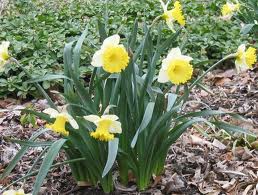AMARYLLIDACEAE
AMARYLLIS FAMILY
Amaryllidaceae includes approxi- mately 50 general of seasonally dor-mant and evergreen herbs widely distributed from mild temperate to tropical regions. Some genera are frequently, but incorrectly, referred to as lilies. of several distinctions from the family liliaceae, perhaps the most readily recognized are the slight bilateral symmetry of the flower, a bent floral neck, and the stamens clustered near the lower tepals. Lilies have evenly radiating tepals and stamens and come pri-marily from temperate regions. The plants are poisonous. Leaves are strap -shaped to orbicular, usually in opposite ranks (distichous), decid-uous, often basal. The bulbs or rhi-zones have contractile roots. Flowers are bisexual with 6 tepals and usually 6 stamens, and are produced on separate stalks (scapes). Some species have a corona (annulus) around the thoat. The inflo-rescence is a cyme or flowers are solitary. Thin spathelike bracts are sometimes located below the flowers. The fruit is a capsule or berry.
Amarcrinum
Amarcrinum is an intergeneric hybrid of Amaryllis and Crinum
Amarctinum memoria – corsii
Crinodonna
Synonym: xA, howardii. Garden origin, Amaryllis belladonna X Crinum moorei. Evergreen perennial herb to 30 in, zones 9-11. Blooms late summer. Regular moisture when warm, less when cool. Fertile, well -drained soil. Full to past sun. Flowers: trumpet-shaped, 2 in. wide, 4 in.long, pink, scape not hollow, to 2 ft.tall. The flowers resemble Amaryllis belladonna but can be dis-tinguished by the evergreen leaves while in bloom. Photographed at Longwood Garden, Kennett Square, Pennsylvania.
Amaryllis
Amaryllis includes a single species of seasonally dormant herb from South Africa. The bulbs were intro-duced into California by early set-tlers and are still widely cultivated in that state. Irrigate plants freely in spring as soon as new leaves begin to emerge and gradually reduce as they wither. Continue to withhold water until the next growing season. Do not plant near moisture- loving species. The bulb is quite drought resistant. Remove leaves after they dry. The flowers will emerge while the leaves are com-pletely dormant (whence the origin of the name”naked ladies” near the end of summer. In cold climates lift the bulbs after flowering and store them in a dry placw. Propagate by division of the bulbs and plant in early spring with the bulb neck above ground level. It takes 2 years to flower from seed. Amarylli is pollinated by birds and insects. Hippeastrum, a mostly New World genus, is commonly, but incorrectly, referred to as amaryllis. Amaryllis is distinguished from Hip- Peastrum by the solid flower stalk (scape) and lack of leaves while in bloom.
Amaryllis elladonna
Belladonna, naked ladies, azucena
Synonym: Brunsvigia rosea. South Africa (Southwest Cape). Season- ally dormant bulbous herb, 18-30 in, zones 8-11. Blooms late summer. Moist during active growth, dry when dormant. Gritty, well drained soil. Full sun to lightly fil-tered midday sun in hot, dry conditions. Flowers: Trumpet -shaped, 2 in, wide, 4-5 in. long, deep pink to white, scape solid, to 2 ft, bearing up to 12 flowers. Leaves: straplike, to 2 ft, fleshy. Belladonna means “beautiful lady”. The species should not to be confused with Atropa bel- ladonna of the potato family, Sola-naceae, from which the drug bella-donna is derived.

Deprecated: strpos(): Passing null to parameter #1 ($haystack) of type string is deprecated in /home/agriviek8Qv/agriviet.net/public_html/wp-includes/comment-template.php on line 2522